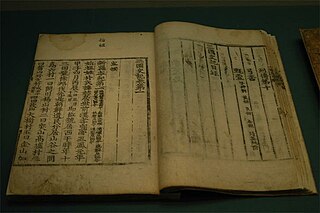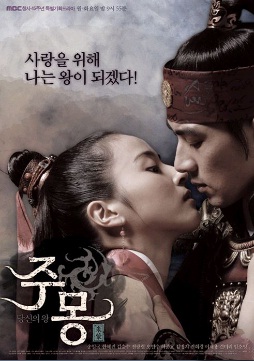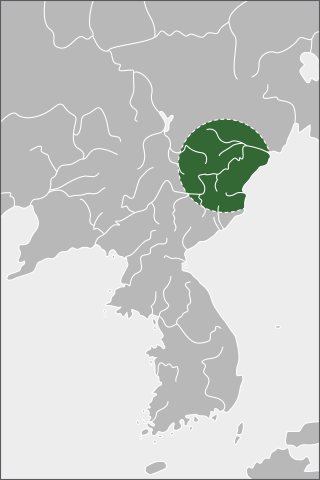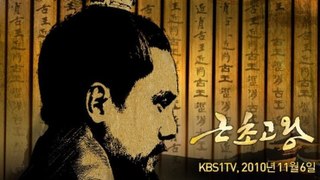Related Research Articles

Goguryeo also later known as Goryeo, was a Korean kingdom which was located on the northern and central parts of the Korean Peninsula and the southern and central parts of modern-day Northeast China (Manchuria). At its peak of power, Goguryeo conquered most of the Korean Peninsula and large parts of Manchuria, along with parts of eastern Mongolia, Inner Mongolia, and modern-day Russia.

Samguk sagi is a historical record of the Three Kingdoms of Korea: Goguryeo, Baekje, and Silla. Completed in 1145, it is well-known in Korea as the oldest surviving chronicle of Korean history.

Baekje or Paekche was a Korean kingdom located in southwestern Korea from 18 BC to 660 AD. It was one of the Three Kingdoms of Korea, together with Goguryeo and Silla. While the three kingdoms were in separate existence, Baekje had the highest population of approximately 3,800,000 people, which was much larger than that of Silla and similar to that of Goguryeo.
Onjo was the founding monarch of Baekje, one of the Three Kingdoms of Korea. According to the Samguk Sagi, he founded the royal family of Baekje.

Wiryeseong was the name of two early capitals of Baekje, one of the Three Kingdoms of Korea. Both are believed to have been in the modern-day Seoul area. According to Samguk Sagi, Onjo, the son of Goguryeo's founder Jumong, founded the nation of Sipje on Wiryeseong in 18 BC, while his elder brother Biryu established himself in Michuhol further to the west. The location of Michuhol is usually believed to be present-day Incheon.
Chaekgye of Baekje was the ninth king of Baekje, one of the Three Kingdoms of Korea.
Bojang of Goguryeo was the 28th and last monarch of Goguryeo the northernmost of the Three Kingdoms of Korea. He was placed on the throne by the military leader Yeon Gaesomun. His reign ended when Goguryeo fell to the allied forces of the southern Korean kingdom of Silla and the Chinese Tang dynasty.

Chumo, posthumously Chumo the Saint, was the founding monarch of the kingdom of Goguryeo, and was worshipped as a god-king by the people of Goguryeo and Goryeo. Chumo, originally Buyeo slang for an excellent archer, later became his name. He was commonly recorded as Jumong by various Chinese sources, including history books written by Northern Qi and Tang. This name became dominant in future writings including Samguk Sagi and Samguk Yusa. Chumo's title was changed to Dongmyeong the Saint, literally translating to the Brilliant Saintly King of the East, at some point in time prior to the compilation of Samguk Sagi (1145). His other names include Chumong, Jungmo, Nakamu, or Tomo. In Samguk Sagi, he was recorded as Jumong with the surname Go, and was also known as Junghae or Sanghae.
King Yuri was the second ruler of Goguryeo, the northernmost of the Three Kingdoms of Korea. He was the eldest son of the kingdom's founder Jumong. As with many other early Korean rulers, the events of his life are known largely from the Samguk Sagi.

Jumong is an epic South Korean historical series that aired on MBC from 2006 to 2007 as the network's 45th anniversary special. Originally scheduled for 60 episodes, MBC extended it to 81 because of its popularity.

Hae Geumwa was the second ruler of Dongbuyeo, an ancient kingdom of Korea. His story is recorded in Samguk Sagi, Samguk Yusa and Book of King Dongmyeong.

Eastern Buyeo, also rendered as Dongbuyeo or Eastern Fuyu, was an ancient kingdom that developed from Northern Buyeo, until it was conquered by Goguryeo. According to the Samguk Sagi, it was established when the Buyeo king Hae Buru moved the capital eastward by the sea.
Biryu (?-?) was the second son of Jumong and So Seo-no, and older brother of Onjo, the traditionally recognized founder of Baekje (18 BCE–660 CE), which was one of the Three Kingdoms of Korea. In an alternate legend, Biryu himself is described as the founder of Baekje.
The Go Royal Family was the dynasty that founded and ruled over the ancient Korean kingdom of Goguryeo. Its founder, Jumong, broke away from another ancient Korean kingdom called Dongbuyeo to start his own kingdom. The Taewangs were all members of the Go Royal Family.

The King of Legend is a 2010 South Korean historical drama based on King Geunchogo of Baekje. Besides historical information from Samguk Sagi and Samguk Yusa, it was also inspired by a novel written by Lee Munyeol, a renowned Korean writer. The drama aired on KBS1 in Korea, and internationally through KBS World.
Wutae, is a figure in the founding legends of the kingdom of Baekje, one of the Three Kingdoms of Korea. He was an illegitimate son or grandchild of the King of Dongbuyeo, Hae Buru (解夫婁).
The Hae clan (解氏) was a powerful noble clan of Baekje, one of the Three Kingdoms of Korea.
Lady Ye was the first wife of Dongmyeong of Goguryeo and mother of his successor, King Yuri.
Creation myth of Baekje is the creation story of Baekje dynasty about Onjo, the first king of the Baejke Dynasty, and Biryu, his elder brother. They were the princes of the Buyeo dynasty, but were not a crown prince. Thus they left Buyeo to establish their own country. Finally, Onjo founded Baekje dynasty.
References
- Kim Bu-sik: Samguk Sagi , volume 23, "Annals of Baekje," chapter 1; King Onjo.